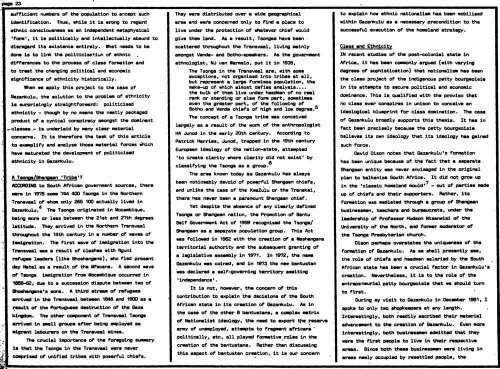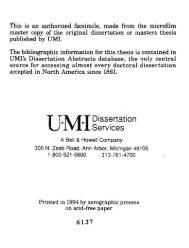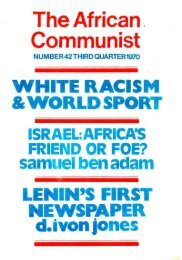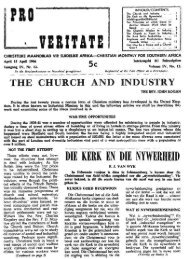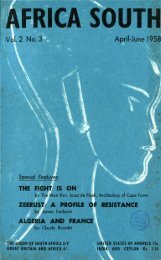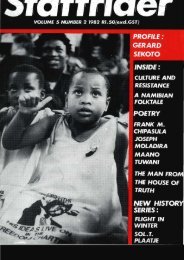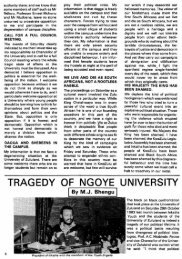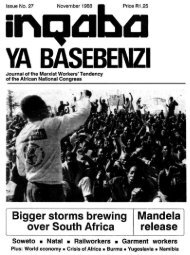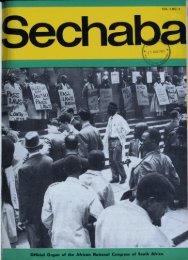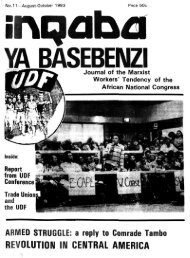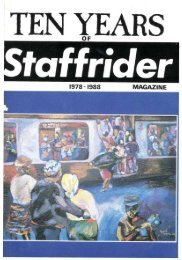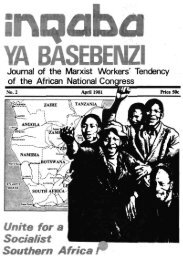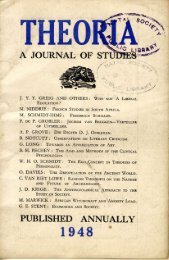You also want an ePaper? Increase the reach of your titles
YUMPU automatically turns print PDFs into web optimized ePapers that Google loves.
page 2&<br />
•officiant nuebers of the population to erxept such<br />
identification. Thus, atilla It la arang to regard<br />
ethnic conacioueneea a* an independent aetaphyelcel<br />
'for* 1 , It la politically and intellectually absurd to<br />
disregard lta existence entirely, anat needs to ba<br />
dona is to link tha polltlcleatlun of athnlc .<br />
dlffarancaa to tha procaaa of claaa foraatlon and<br />
to traat tha changing political and aconoalc<br />
aignlficanca of ethnicity historically,<br />
lhan aa apply thla projact to tha caaa of<br />
Bazankulu, tha eolution to tha problaa of athnlcity<br />
la eurprielngly streightforeard: politiciaad<br />
athnlcity - though by no aeons tha naatly peckaged<br />
product of a cynical conapiracy aaongst tha doainant<br />
* olaaaaa - la undarlald by aany claar aatarlal<br />
concarne. It ia therefore tha teak of this artlcla<br />
to axaapllfy and analyaa thoaa aatarlal forcaa which<br />
hava maturated tha development of politiciaad<br />
athnlcity In Gezankulu.<br />
A Taonoo/Shangaan 'Tribe'?<br />
ACCORDING to South African govornaont sources, thara<br />
aara In 1975 aoaa 7de 400 Teonge in tha Northam<br />
Tranavaal of ahoa only 266 100 actually llvad in<br />
Gezankulu. Tha Taonga orlglnatad in Uocaabloua,<br />
balng aim or laaa bataaan tha 21at and 27th dagraaa<br />
latitude. Thay arrived in tha Northam Tranavaal<br />
throughout tha 14th cantury In a nueber of aavaa of<br />
iaadgratlon. Tha flrat aava of laalgration Into tha<br />
Tranavaal aaa a raault of claahaa with Ngunl<br />
rafugaa laadara (ilka Qhoanangana), aho flad praaant<br />
day Natal aa a raault of tha tffecane. A aacond aava<br />
of Taonga iaadgratlon froa Hocanbiqua occurrad In<br />
1850-6?, dua to a auccaaalon diaputa bataaan tao of<br />
ahoahangana*a aona. A third atraaa of rafugaaa<br />
arrived In tha Tranavaal bataaan 1646 and 1900 aa a<br />
raault of tha Portugueee destruction of tha Gaza<br />
kingdom. Tha othar coaponant of Tranavaal Taonga<br />
arrivad In small groupa aftar baing aaployad aa<br />
algrant labourara on tha Tranavaal alnee.<br />
Tha crucial laportanca of tha foregoing auaawry<br />
ia that tha Taonga In tha Tranavaal aara navar<br />
| coaprlaad of unlfiad tribaa alth poaarful chiefs.<br />
Thay aara distributed over a alda geographical<br />
araa and aara concerned only to find a place to<br />
live under the protection of whatever chief aould<br />
give thaa) land. Aa a raault, Taongaa have been<br />
ecettared throughout tha Tranavaal, living eulnly<br />
amongst Venda- and Sotho-speafcera. Aa the govarneemt<br />
ethnologiet, NJ van aaraalo* put it In 1935,<br />
Tha Taonga In tha Tranavaal ara, eith aoae<br />
exceptions, not organlaad into tribes at all,<br />
but represent a larga fonaleee population, the<br />
aaka-up of ahlch elmoet defies anelyela....<br />
tha bulk of thaa live under haadaan of no real<br />
rank or atandlng or alee fora part, sometimes<br />
even the greater part, of tha folloeing of<br />
Sotho and Vande chiefs of high end loa degree. 3<br />
Tha concept of a Taonga tribe aaa conceived<br />
largaly aa a raault of the aortt of the anthropologist<br />
HA Junod in the early 20th cantury. According to<br />
Patrick Harriee, Junod, trapped in tha 19th century<br />
European Ideology of the nation-etata, attaapted<br />
•to creoto clarity ahere clarity did not axlat* by<br />
classifying the Taonga aa a group*<br />
Tha araa knoen today aa Gezankulu has eleaya<br />
bean noticeably devoid of poaarful Shangaen chlefe,<br />
and unlike tha caaa of the KeaZulu or the Tranaksi,<br />
thara hee never been a paramount Shangean chief.<br />
Yet deaplte tha abaanca of any clearly defined<br />
Taonga or Shengaan nation, the Promotion of Bantu<br />
Self Governeaint Act of 1969 racognlaad the Taonga/<br />
Shengaan aa a separate population group • Thla Act<br />
aaa folloaad in 1962 eith tha craation of a llaahangana<br />
tarritorlal authority and the subsequent granting of<br />
a legislative aaseably in 1971. In t972, tha nee*<br />
Gazankulu aaa coined, and In 1973 the nee bentuatan<br />
aaa daclared a aalf-governing tarritory eeelting<br />
* Independence •.<br />
It 1* not, hoaever, tha concern of thie<br />
contribution to explain the declalone of the South<br />
African stata in lta creetlon of Gazankulu. Aa in<br />
tha case of the other 8 bantuatana, a conplex matrix<br />
of Nationalist ideology, tha need to export tfie reeervo<br />
aray of unemployed, atteepte to fragaant afrlcana *<br />
politically, etc, all played foraatlve rolaa in the<br />
craation of tha bantuatana. Bather than diacuaaing<br />
thla aspect of bentuatan craation, it la our concern<br />
to explain hoe ethnic nationalise has been aoblliasd<br />
within Gazankulu aa a neceeeary precondition to the<br />
aucceasful execution of the hoaxtlend strategy.<br />
Class and Ethnicity<br />
IN recent atudiaa of the poet-colonial atata in<br />
Africa, it hee been coaaonly argued (eith varying<br />
degreee of sophietlcation) that nationalise) haa been<br />
the cleaa projact of tha Indigenous petty bourgeolelo<br />
in lta atteepte to eecure political and economic<br />
doalnence. Thie la qualified with the proviso that<br />
no claaa aver consplrea in unlaon to conceive an<br />
ideological bluaprint for clasa domination. Tha caaa<br />
of Gazankulu broadly aupporta thla theela. It hea In<br />
feet bean precisely because tha petty bourgeolala<br />
believee lte oen ideology that lta ideology haa gained<br />
auch force.<br />
David Dieon note* that Gezankulu's formtlon<br />
haa bean unique beceuae of the fact that a aeparata<br />
Shengaan entity aaa rmtv envisaged in tha original<br />
plan to balkaniaa South Africa. It did not groe up<br />
in tha *claaalc hoaaland aould' 7 - out of pertlaa made<br />
up of chiefs and their eupportera. Rather, its<br />
foraatlon aaa mediated through e group of &tangean<br />
buslnasaaisn, taechera and bureaucrats, under the<br />
leadership of Professor Hudaon Ntsane/iei of tha<br />
Unlvaralty of the North, and former moderator of<br />
the Taonga Presbyterian church.<br />
Olaon pernaps overetatee tha unlojuanaaa of tha<br />
foraatlon of Gazankulu. Aa ee shell praeantly aaa,<br />
the rola of chiefe and hsaoaen aalarlad by the Couth<br />
African atata haa baan a oruclal factor in Gezankulu'a<br />
craation, Navarthalaaa, It la to tha rola of tha<br />
entrepeneurial patty bourgeolala that aa should turn<br />
to flrat.<br />
During ay visit to Gazankulu in Oacaabar 1961, I<br />
apoke to only tao ehopfcaepere at any length,<br />
Intereetingly. both readily aacrlbed their eaitarial<br />
advancaasnt to the craation of Gazankulu. Evan aura<br />
lntereatlngly, both buelnssaaan edeltted that they<br />
aara tha flrat paople to live in their raepective<br />
arees. Since both thaaa bualnssaaan aara living in<br />
areas neely oocupied by raaattled paopla, the


